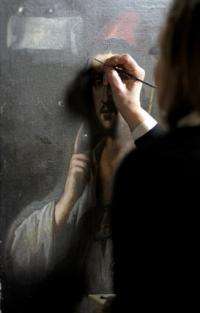Caravaggio used photographic techniques: researcher

Italian Renaissance painter Caravaggio used revolutionary optical instruments to "photograph" his models more than 200 years before the invention of the camera, according to a researcher in Florence.
The 16th-century artist celebrated for his dramatic chiaroscuro (light and shadow) paintings mastered "a whole set of techniques that are the basis of photography", Roberta Lapucci told AFP.
Caravaggio worked in a "darkroom" and illuminated his models through a hole in the ceiling, said Lapucci, who teaches at the prestigious Studio Art Centers International in the Tuscan capital.
The image was then projected on a canvas using a lens and a mirror, she said.
Caravaggio "fixed" the image, using light-sensitive substances, for around half an hour during which he used white lead mixed with chemicals and minerals that were visible in the dark to paint the image with broad strokes, Lapucci said.
She has hypothesised that Caravaggio used a photoluminescent powder from crushed fireflies, which was used at the time to create special effects in theatre productions.
One of the main elements of these mixtures was mercury -- to which prolonged exposure can affect the central nervous system causing irritability and other symptoms -- which Lapucci said would help explain Caravaggio's notorious temper.
One of his many brawls ended in the death in 1606 of a young adversary, Ranuccio Tomassoni, which forced him to flee Rome to Malta.
"The entire set-up was suggested to him by his friend Giovanni Battista Della Porta, a physicist," Lapucci said. "Caravaggio was very tied to a community of scholars interested in optics."
While Leonardo da Vinci (1452-1519) had earlier described the "camera obscura" or darkroom, Caravaggio was the first painter to use it, Lapucci said.
The Italian researcher has collaborated with British artist David Hockney, who wrote in his 2001 book "Secret Knowledge" that Caravaggio and later the Flemish Baroque artist Anthony Van Dyck (1599-1641) and French neoclassical painter Jean Auguste Dominique Ingres (1780-1867) used optical instruments to compose their paintings.
Art historians say the assertions have not been proven and complain that they devalue the artists' genius.
"There is lots of proof, notably the fact that Caravaggio never made preliminary sketches," Lapucci insisted. "So it is plausible that he used these 'projections' to paint."
Noting that "an abnormal number of his subjects were left-handed," Lapucci said: "That could be explained by the fact that the image projected on the canvas was backwards."
She added: "This anomaly disappears in the artist's later works, a sign that the instruments he used were improving. Also thanks to technical progress, his paintings gain a lot in depth of field over the years."
Lapucci is especially keen to refute charges of detracting from the artist's work: "His mastery of certain techniques before his time in no way diminishes his genius. To the contrary: clearly, you can't just project images on a canvas and copy them to become a Caravaggio!"
(c) 2009 AFP
















